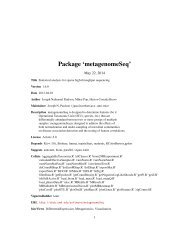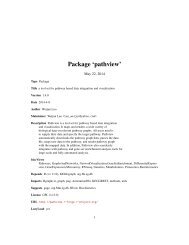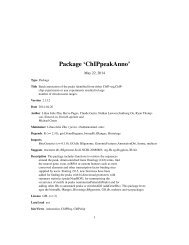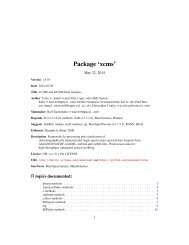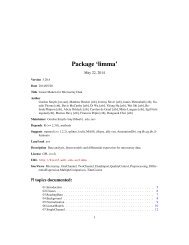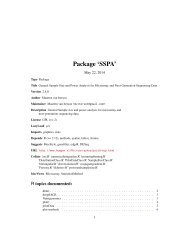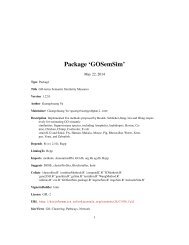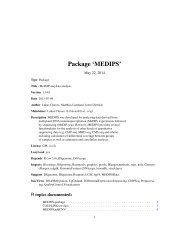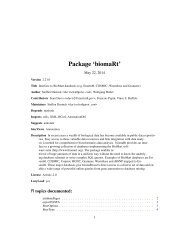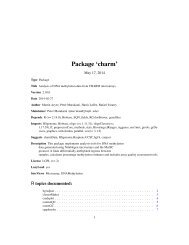Package 'pvca' - Bioconductor
Package 'pvca' - Bioconductor
Package 'pvca' - Bioconductor
You also want an ePaper? Increase the reach of your titles
YUMPU automatically turns print PDFs into web optimized ePapers that Google loves.
<strong>Package</strong> ‘pvca’<br />
April 5, 2014<br />
Type <strong>Package</strong><br />
Title Principal Variance Component Analysis (PVCA)<br />
Version 1.2.0<br />
Date 2013-09-25<br />
Author Pierre Bushel <br />
Maintainer Jianying LI <br />
Description This package contains the function to assess the batch sourcs by fitting<br />
all ``sources'' as random effects including two-way interaction<br />
terms in the Mixed Model(depends on lme4 package) to selected principal components,<br />
which were obtained from the original data correlation matrix. This package accompanies<br />
the book "Batch Effects and Noise in Microarray Experiements, chapter 12.<br />
Depends R (>= 2.15.1)<br />
Imports Matrix, Biobase, vsn, lme4<br />
Suggests golubEsets<br />
biocViews Bioinformatics, Microarray, BatchEffectAssessment<br />
License LGPL (>= 2.0)<br />
LazyLoad yes<br />
R topics documented:<br />
pvca-package . . . . . . . . . . . . . . . . . . . . . . . . . . . . . . . . . . . . . . . . 2<br />
pvcaBatchAssess . . . . . . . . . . . . . . . . . . . . . . . . . . . . . . . . . . . . . . 2<br />
Index 5<br />
1
2 pvcaBatchAssess<br />
pvca-package<br />
A package that provides an approach to assess the source of batch<br />
effects in a microarray gene expression experiment<br />
Description<br />
Details<br />
This package contains the function to assess the batch sources by fitting all "sources" as random<br />
effects including two-way interaction terms in the Mixed Model(depends on lme4 package) to selected<br />
principal components, which were obtained from the original data correlation matrix. This<br />
package accompanies the book "Batch Effects and Noise in Microarray Experiements, chapter 12.<br />
<strong>Package</strong>: pvca<br />
Type: <strong>Package</strong><br />
Version: 1.0<br />
Date: 2012-09-11<br />
License: LGPL (>= 2.0)<br />
library(golubEsets)<br />
data(Golub_Merge) pct_threshold
pvcaBatchAssess 3<br />
Description<br />
This package contains the function to assess the batch sources by fitting all "sources" as random<br />
effects including two-way interaction terms in the Mixed Model(depends on lme4 package) to selected<br />
principal components, which were obtained from the original data correlation matrix. This<br />
package accompanies the book "Batch Effects and Noise in Microarray Experiements, chapter 12.<br />
Usage<br />
pvcaBatchAssess(abatch, batch.factors, threshold)<br />
Arguments<br />
abatch<br />
batch.factors<br />
threshold<br />
an instance of ExpresseionSet which can be imported from Biobase<br />
A vector of factors that the mixed linear model will be fit on<br />
the percentile value of the minimum amount of the variabilities that the selected<br />
principal components need to explain<br />
Details<br />
Often times "batch effects" are present in microarray data due to any number of factors, including<br />
e.g. a poor experimental design or when the gene expression data is combined from different<br />
studies with limited standardization. To estimate the variability of experimental effects including<br />
batch, a novel hybrid approach known as principal variance component analysis (PVCA) has been<br />
developed. The approach leverages the strengths of two very popular data analysis methods: first,<br />
principal component analysis (PCA) is used to efficiently reduce data dimension while maintaining<br />
the majority of the variability in the data, and variance components analysis (VCA) fits a mixed<br />
linear model using factors of interest as random effects to estimate and partition the total variability.<br />
The PVCA approach can be used as a screening tool to determine which sources of variability (biological,<br />
technical or other) are most prominent in a given microarray data set. Using the eigenvalues<br />
associated with their corresponding eigenvectors as weights, associated variations of all factors are<br />
standardized and the magnitude of each source of variability (including each batch effect) is presented<br />
as a proportion of total variance. Although PVCA is a generic approach for quantifying the<br />
corresponding proportion of variation of each effect, it can be a handy assessment for estimating<br />
batch effect before and after batch normalization.<br />
Value<br />
dat<br />
label<br />
A numerica vector contains the percentile of sources of batch effect for each<br />
term<br />
A character vector containing the name for each term for plot label purpose<br />
Note<br />
Modified and maintained by Jianying Li<br />
Author(s)<br />
Pierre Bushel
4 pvcaBatchAssess<br />
Examples<br />
library(golubEsets)<br />
data(Golub_Merge)<br />
pct_threshold
Index<br />
∗Topic BatchEffect<br />
pvcaBatchAssess, 2<br />
∗Topic MixedModel<br />
pvcaBatchAssess, 2<br />
∗Topic PCA<br />
pvcaBatchAssess, 2<br />
∗Topic package<br />
pvca-package, 2<br />
pvca (pvca-package), 2<br />
pvca-package, 2<br />
pvcaBatchAssess, 2<br />
5



